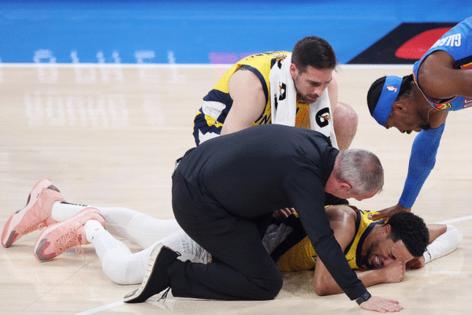Mac Engel: Tyrese Haliburton's injury, and the same for so many others, has easy explanation
Published in Basketball
FORT WORTH, Texas — Outside of Oklahoma, Tyrese Haliburton slamming his right hand on the floor in pain will be the lasting memory of the NBA Finals.
Once the Indiana Pacers all-star suffered an apparent Achilles injury in the first quarter of Game 7 on Sunday night, so did his team’s realistic chances of winning a NBA title against the Thunder.
At this point, we are sad, slightly disgusted, but mostly numb watching another great player suffer a franchise-altering injury.
“It’s all Xs and Ys chromosomes. That’s what happened when mom and dad got together,” said former long-time athletic trainer Chris Hall, who worked in the TCU athletic department and Texas Health sports orthopedic services for more than 40 years.
“With all of the diagnostic testing out there, there is still not a viable test that is going to tell you of the bad things that are going to happen to a player when they start playing. I am sure (the Pacers) did everything right, and Haliburton wanted to play because it’s Game 7, and this happened.”
In the last 20 years, strength training has elevated the human body to a performance level that neither George Orwell, nor Vince Lombardi, could have foreseen. And all of these advances can’t do much of anything to make the human tendons hold up under the pressure required to support the throws by a Major League pitcher, or the demands by an NBA player.
All of these injuries are not hard to figure out why. Too big. Too fast. Too lean. Too much muscle. Too many games (*).
Sports billion dollar injured list
Haliburton is just the latest big money all-star to go down at an important time.
Kevin Durant’s Achilles tear in Game 5 of the 2019 NBA Finals. Milwaukee’s Dame Lillard suffered the same injury in these playoffs, like Boston’s Jayson Tatum. Dallas Mavericks guard Kyrie Irving suffered a torn ACL in March.
In baseball, the list of injured prominent pitchers is so long that we’re surprised when a player has not had Tommy John surgery. Jacob deGrom. Shohei Ohtani. Sandy Alcantara. Gerrit Cole. Shane McClanahan, Walker Buehler, Dustin May, Chris Paddack and Hyun Jin Ryu are also on the list.
Then there is another list of guys who have had the same season-ending surgery twice. DeGrom is a part of that one, too, just like teammate Nathan Eovaldi.
The NFL’s injury report is almost worse.
It’s hundreds and hundreds of millions of dollars sitting on injured reserve, hamstringing franchises that have no choice but to commit enormous contracts to people while praying they don’t suffer this type of injury.
Hard not to see why the injury trend is stuffed
Despite the introduction of “load management,” pitch counts, first class treatments and accommodations, or night’s off, nothing is preventing these injuries.
Just look at the player of today compared to 1985. Or 1995.
During his 13-year NBA career, Larry Bird averaged, including the playoffs, 81 games a season. Before he had to retire because of an HIV diagnosis, Magic Johnson averaged 88 games. Nine times during his 15-year career, Michael Jordan played all 82 regular-season games, including the final year of his career when he was 39.
By the time Jordan was in his final seasons, weight training and performance coaching were becoming widespread and a point of emphasis for teams and college programs.
Thanks to advances in training and nutrition, performance and skill levels increased in virtually every sport. The new methods emphasize explosion, more muscle and low body fat.
The offensive lineman evolved from big to massive with quick feet. Linebackers don’t look human.
Current Baltimore Ravens running back Derrick Henry is 6-foot-3, 247 pounds. In 1977, Art Shell of the Oakland Raiders was listed at 6-5, 265. He was a left tackle.
Most MLB pitchers can throw a baseball at 97 mph, while putting spin on it that is worse on the elbow than opposing hitters.
“Look at basketball players now,” Hall said. “Look at what the big guys can do now; 25 years ago, no big guys could do that. And look at the level of competition now. It adds up, especially if you are working with a strength and conditioning guy who wants to push the envelope.”
Add in the realities that beginning about 20 years ago young kids started playing sports year round only increases the mileage, and the risk of something catastrophic.
While all of this has improved performance, the one part that hasn’t changed are the tendons that support all of this stress. Some are better than others, and there is no way to predict when they’ll snap.
Watching Haliburton slam his hand down on the floor is the lasting memory of the NBA Finals, but by now we’re numb to it.
Because too big. Too fast. Too lean. Too much muscle. Too many games (*).
____
©2025 Fort Worth Star-Telegram. Visit star-telegram.com. Distributed by Tribune Content Agency, LLC.







Comments